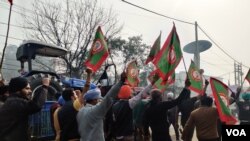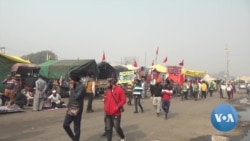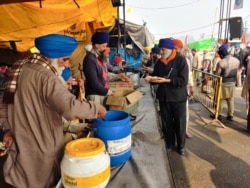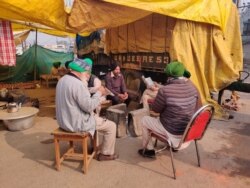Hundreds of young, educated men like Manveer Singh who defy the typical image of the Indian farmer are among the sea of protesters camped along a highway at Delhi’s borders to demand the scrapping of three new farm laws.
The 27-year-old postgraduate in information technology turned to farming after struggling for five years to find a job that would pay a modest wage.
“After my education, I was hoping to get a white-collar job, and I gave many interviews,” Singh says, as he sits outside his tractor trolley – one of scores that have turned into homes for farmers who have come from neighboring states like Punjab. “But I never got any offer that pays more than $ 140 a month.”
Violence this week in which hundreds of farmers stormed into New Delhi and breached the historic Red Fort and more clashes Friday at one of the main protest sites have raised questions about the future course of what have been called the world’s largest protests.
The farmers blame politicians for instigating the skirmishes and are vowing to persevere with their two-month struggle, which is dominated by farmers from the predominantly agricultural state of Punjab.
The young, educated people who have come on tractors and trolleys to Singhu, on New Delhi’s outskirts, highlight India’s growing problem of joblessness among young people. It is the epicenter of the farm protests.
As they sit browsing their smartphones and help in cooking and serving community meals, they say tilling family farms is their only security in a state where unemployment among young people at 21.6 percent exceeds the national average of about 17.5 percent.
The protest was triggered by three new laws that open up sale of farm produce to private players. The government says this will modernize a sector that desperately needs an overhaul and improve farm incomes by attracting private investment.
But protesters fear the reforms will benefit private buyers at their expense, hurting agricultural incomes, eventually forcing them to sell their land by driving them into debt. The government currently buys crops like rice and wheat grown extensively in Punjab at a fixed price.
Losing their lifeline
Young people say being exposed to market forces is particularly worrisome for them. Punjab was one of India’s richest states until a few decades ago, but its failure to create an industrial or services sector has resulted in the paucity of jobs, making farming their lifeline.
Kulwinder Singh, who has been at the protest site for two months, symbolizes the frustration of young people. His hopes of becoming a teacher never bore fruit. But the seven-acre family farm of the 32-year-old makes it possible for him to sustain his family.
“I have a bachelor’s degree in education, and after that I did another course, which I hoped would get me employment,” he says. “But there are no jobs.”
It’s a story repeated by many young people here. Since the stir began two months ago, Hardev Singh has been crawling into his tractor truck every night to spend the cold Delhi winter with other family members. Although he has a job, the loss of livelihoods during the pandemic has made him insecure.
“In case I lose my job, at least I can farm my land. If I don’t have that fallback, what will I do?” asks Singh. “I won’t even have food to eat.”
Old and young farmers on the borders say the recent violence will not deter them from making the highways their home until their demands are met. The protesters have rejected the government’s offer to put the laws on hold for up to a year and a half, and they remain adamant the laws must be repealed.
Hardev Singh points to the example of some states, where allowing the sale of farm produce failed to draw investment or higher prices. “We will take the fight to the end,” says Singh. “Until the laws are scrapped, we will sit here peacefully.”
Growing frustrations
But tensions are rising at protest sites. At the Singhu border, police used tear gas and batons to break up clashes Friday between farmers and a group of people demanding the farmers vacate the highway.
Although the government has assured them that no one can take their land, the protesters remain unconvinced.
The anger at these protest sites, say economists, highlights India’s failure to create enough non-farming jobs for a country where two-thirds of the 1.3 billion population is under 35.
Economist Santosh Mehrotra, author of the book “Reviving Jobs: An Agenda for Growth,” calls youth unemployment “the most serious issue that the country faces.” He says India has not done enough to move people out of agriculture into alternate livelihoods.
He points out that while a number of young people in Punjab have been able to migrate due to a huge Punjabi diaspora overseas, those left behind face the challenge of underemployment on farms that have become smaller in size as they pass down to subsequent generations.
As they live out that crisis, Manveer Singh is disconsolate as he peels radishes for a community meal. “We have such a huge population that we and even our future generations have no hopes of finding a job.”
The frustration among young people poses a huge challenge to Prime Minister Narendra Modi, who came to power six years ago promising development and jobs — a promise that the young people at the protest site say he has failed to meet.
















